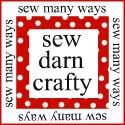It is generally thought to be a cross between knitting and crocheting, as there are many similarities to each. The needle used for Tunisian Crochet looks like a crochet hook on one end and a knitting needle on the other. Only one needle is used at a time as in crochet, but many stitches are held on the needle at one time as in knitting. As in both knitting and crocheting, there is a huge variety of stitches that can be formed using Tunisian Crochet. There is one main difference though, and that is Tunisian Crochet is always worked from the front. The work is never turned. Because of this, Tunisian Crochet always forms a fabric that has a definite front side and back side.
Tunisian Crochet is also prone to curling at the ends so it is highly recommended that pieces be blocked before being stitched together or finished into blankets or garments. This curling is caused by there being generally more bulk of yarn on the back side of the piece than on the front which forces the fabric to curl forward. It is almost always recommended to use a needle two or three times larger than what is suggested for the yarn that is being used. This helps to reduce the curling, but does not eliminate it.
Ok, enough talk about it...let's get down to business!
The extra large light blue hook is a size Q which is gigantic in diameter, but not very long and does not have a stopper at the end. This could be used for Tunisian Crochet when making something narrow such as a scarf, or panels for an afghan that will be stitched together later. This is the needle I used to crochet my very first afghan when I was about 12 years old! Unless the desired effect is very loose and lacy, two strands of yarn would be used with this hook.
The last two hooks are two different sizes of the same type of hook. You can see the stopper at the end just like a knitting needle, and the hook at the other end just like a crochet hook. Also notice that these hooks do not have the little flat part in middle like regular crochet hooks have where you rest your thumb and finger. This is because many stitches are held on the needle at one time and they need to remain consistent in size. The stitches also need to be able to move freely across the needle as in knitting.
As mentioned in the video, there are quite a number of different stitches in Tunisian Crochet and the next one I am going to show you is called Tunisian Stockinette. My friend Merry from the Knittinghelp.com forum that I love to read has also asked for some help with a project that calls for Tunisian Short Row. I will be sharing a pattern for a lovely dish cloth that Merry wants to make and a video showing how you can make one yourself using your new skills in Tunisian Crochet.
Happy Stitching!

Click here to return to HookedOnNeedles.com
Labels: afghan stitch, crochet, Tunisian Crochet






















